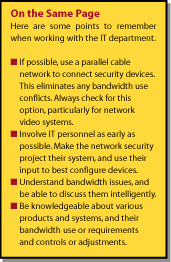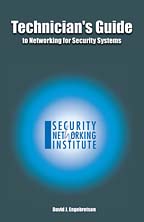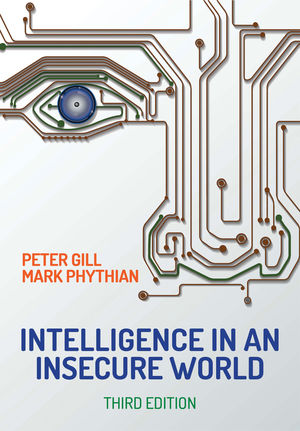The‘‘Parallel’’ World with IT


IT responsibilities
Understanding the IT perspective allows security to best craft discussions and presentations of new technologies, and increases the potential cooperation of personnel who can make or break the sale of a system or its installation.To paraphrase a previously used analogy, conceptualize the existing network as an interstate highway and the IT management function as traffic cops, allowing or disallowing traffic on their piece of road. Understanding their requirements and being able to explain what impact the new equipment may or may not have on network traffic will go a long way toward smoothing out what can be a contentious relationship among in-house security executives, an alarm company, systems integrators and an IT department.
To best understand IT concerns, it’s necessary to understand IT’s responsibilities. The IT management job is not just to manage the cable plant, computer hardware and software used in the enterprise network; they must also manage subordinates who work on the system. Another overriding responsibility is to function as the human interface for all of a computer system’s users, which usually encompasses nearly every person in an organization. If and when users have problems with their computers, they will be calling the IT department for assistance.

Constant pressure is placed on IT to provide, install or allow new software and hardware products for system users. Also from IT’s perspective, any new product, software or service that is placed on his or her network must be supported. They have to understand it, be able to troubleshoot it and explain its functions to users. With reduced personnel counts in their department and the uncertainty of functionality, IT people tend to be reluctant to accept new devices on their network. Their easiest answer is “No,” and pressure from upper management may be required to change their opinion.
IT managers are powerful people in a business or organization. They have the power to allow or disallow equipment, products and services onto their network. Although a brand new, separate and private cabling and hardware network can be installed to provide connectivity for a networked electronic security system, it will be much faster and cheaper to use existing network paths for security communications. And use of existing network paths will involve IT personnel, who must be carefully cultivated by security.
Successful implementation of a network security system integrated onto the customer’s enterprise network requires the active and positive involvement of the enterprise’s IT department.
One of the most important responsibilities of the IT department is the protection of the enterprise’s network and data from hackers, both outside the organization and within. This computer network security issue is another reason why IT people may be reluctant to embrace the installation of IP-addressed cameras, video servers and alarm transmitters onto their system. The perception of the IT department may well be that new devices provide new security holes, which must subsequently be closed, managed or monitored.

Network worries
Once upper management has been presented the concepts of networking electronic security – for example, connecting a campus of buildings into a central monitoring station – it is important to involve IT management very early. For all of the reasons listed above, the buy-in by IT of the proposed system is critical to its success. If the relationship is positive, there may well be unexpected benefits, producing a networked security system that is lower cost, higher security or both.The easiest and best way to provide a top-notch networked security system is to use a parallel network cabling system. By using some otherwise unused conductivity, security signals can travel within a building or around a campus without taking any bandwidth away from the enterprise network.
If a preferred parallel network concept is unavailable, security devices must be connected to an enterprise network to allow signal transmission and access to security equipment. Connection of access control, alarm signal transmitters and similar devices will have little or no impact on the performance of the enterprise network, as these devices require little bandwidth and, more importantly, will only be using the network periodically.

The quality of the image, number of frames per second and compression algorithm used will determine the approximate bandwidth requirement of a security video feed. Security contractors should keep in mind that video bandwidth requirements may fluctuate based on the type of image and amount of movement within the camera’s viewing field.
It is important to remember that when connecting to a wired Ethernet network, the concentration of multiple cameras or video servers onto backbone segments can add up to heavy bandwidth requirements. For example, if five video servers, each using 2 Mbps of bandwidth, are connected to a network switch in a horizontal cross connect, 10 Mbps of bandwidth in the backbone will be needed to transmit those video signals to the main cross connection point. If the backbone operates at 100 Mbps, now 10 percent of the backbone’s capability is being used for security video feeds.
However, if the five video servers were each connected to different horizontal cross connects, each would only be taking up 2 percent of its connected backbone’s capacity. For networks that operate at 1000 Mbps for backbone connections, the addition of a number of 2 Mbps security video server feeds should be of minor concern to IT management.
If the enterprise is the 9:00-to-5:00, closed-on-the-weekends type, it is possible that the video servers, DVRs or IP cameras may be programmed to transmit fewer frames per second during the workday, and go to maximum frame rates during off-hours. This can be done manually by connecting to each remote IP security device when bandwidth changes are needed. As networked security devices become user-friendlier, this type of variable speed transmission may well become a pre-programmable scheduled function.
Another approach to video bandwidth over an enterprise can be to ask IT management how much bandwidth can be allocated for video purposes across the network.
This concept can help involve the IT personnel in the early stages, as the security contractor can work with IT to plan out the best implementation of the networked video system. The benefit of this approach is that IT personnel can develop some ownership of the project, as their bandwidth design is included. After determining bandwidth capabilities, security can either determine what equipment meets the requirements and/or how to throttle IP cameras and video servers so as not to exceed the planned bandwidth usage.

Sidebar: Hot for Networking
David Engebretson, author, lecturer and practitioner, is also president of the SecurityNetworkingInstitute.com. In addition to his recent publication, The Technician’s Guide to Networking for Security Systems, he will present two educational sessions at the upcoming International Security Conference Las Vegas. One ISC session – Networking Security- New Superhighways, New Applications – covers IP-addressed cameras, DVRs, video servers and access control connections. The other ISC session is VoIP and Alarm Transmissions.Looking for a reprint of this article?
From high-res PDFs to custom plaques, order your copy today!






